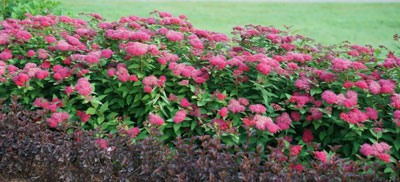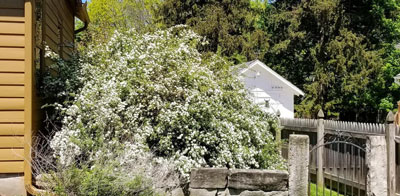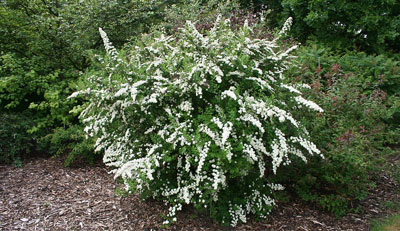Spirea (spy-REE-uh ), is also known as Meadowsweet, and is a genus of flowering, woody, deciduous, perennial shrubs belonging to the rose family (Rosaceae). Spirea plants are prized for their attractive, color-changing foliage, organized clusters of hundreds of small blossoms, and for their versatility in your landscape. With approximately 80-100 species native to temperate regions of the Northern Hemisphere, Spirea has become a popular choice for gardeners and landscapers worldwide. Additionally, Spirea has a rich history, including traditional medicinal uses.
Key Characteristics:
- Growth Habit: Spirea shrubs typically range from 2 to 9 feet tall and wide, depending on the species and cultivar. They often have a mounded or arching form.
- Foliage: The leaves are usually small to medium-sized, simple, and arranged alternately on the stems. Depending upon the variety and the season, the finely-toothed foliage color can range from green to yellow to orange to red, and gold or even purple.
- Flowers: One of Spirea’s most desirable features is its prolific blooming habit. Petite flowers cluster together in dense groups called corymbs (flat-topped clusters of flowers) or panicles (a branched, elongated cluster of blossoms), creating quite the dramatic display. Flower colors include white, many shades of pink, and varied red hues.
- Blooming Season: Most Spirea bloom in late spring to early summer, though some varieties may rebloom or flower later in the season.
- Durability and Adaptability: Spirea are durable, drought-tolerant, deer-resistant, and disease-resistant perennial shrubs. Meadowsweet will tolerate poor soil, chilly weather, hot temperatures, drought, mugginess, and metropolitan pollution. Even in the worst of circumstances, this robust shrub will attract pollinators in droves.
- Hardiness: Most Spirea will be hardy in USDA Zones 3 to 8.
Popular Species:
Spiraea japónica (sah-PONE-ee-kuh): Also known as Japanese Spirea is recognized by its pink to red clusters of blossoms, known as corymbs and the widest variety of foliage colors. This species will grow from 2 to 6 feet high and up to 7 feet wide.
One Notable Cultivars is:

Double Play® Spirea: This variety is celebrated for its vast selection of cultivars with flamboyant foliage and flowers. In the spring, new growth emerges in shades of burgundy or purple, transitioning to green as the season progresses. The abundant clusters of pink flowers bloom in early to mid-summer, providing a striking contrast against the colorful leaves. When compared to other varieties of Spirea, Double Play is particularly distinguished by its striking foliage color and extended blooming season.
Spiraea x vanhouttei (van-HOW-tay): may be known as Vanhoutte Spirea or Bridal Wreath Spirea and features heavily flowered branches that arch gracefully towards the ground. This hybrid is vase-shaped, regularly reaching heights of 8 feet, while spreading a bit wider.
One Notable Cultivars is:

Renaissance, which is covered in panicles of white blossoms and usually grows a bit wider than it is high, bears striking fall foliage colors, in varying shades of orange and red. As with most Spirea, Renaissance is beautiful in 3 out of the 4 seasons.
Spiraea prunifolia (prune-ĭ-foal-ee-uh): This old fashioned Spirea shrub is also commonly referred to as Bridal Wreath Spirea. This species produces double white blossoms along its twiggy branches in early spring, closely resembling Vanhoutte Spirea, though its branches tend to more upright growth, as opposed to arching. Its foliage emerges in shades from bright chartreuse to bluish-green to forest green. This clumping deciduous, shrub has a mounded habit, growing from 4 to 9 feet tall.
One Notable Cultivars is:

Bridal Wreath Spirea: This is the Spirea that is actually the original Spirea; you might call if an “Heirloom” variety. Its blossoms are very similar to baby’s breath, their lacy appearance one of the most recognizable Spirea, often found growing wild and unhindered along country roads.
Spiraea betulifolia (bay-tuh-leaf-OH-lee-uh): This Spirea Is a compact, native North American species, sometimes called Birchleaf Spirea. It displays clusters of dainty white blossoms atop eye-catching foliage with a stunning fall display. This Spirea will typically grow 3 to 4 feet wide and tall.
One Notable Cultivars is:

Glow Girl® Spirea: This aptly-named woody shrub is recognizable for its glowing gold foliage and concave corymbs. Its blossoms bud with just a hint of red, opening to striking white with gold-topped stamens. In the fall, you’ll be dazzled by its brilliant, multi-hued, color-changing foliage.
Spiraea nipponica (ni-pone-eye-CEE-a): Native to Japan, this species blooms in late spring with clusters of small white flowers that cover the gracefully arching branches. Unlike most Spirea, the foliage will not put on the best show, though it does create a lush, green background for the zillions of blossoms on each shrub.
One Notable Cultivars is:

Snowmound: This Spirea got its name from the mounds of flowers it produces that look remarkably like mounds of snow, from a distance. This compact Spirea only grows 3 to 5 feet high and has unremarkable fall foliage, though its spring foliage is lush, with leaves that are oval and lightly scalloped.
Designing with Spirea:
Spirea’s versatility and adaptability makes it suitable for various garden applications:
Foundation Plantings: Spirea is an excellent choice for foundation plantings because of its attractive foliage and seasonal flowers. When planted along the base of a house or building, Spirea can soften the structure’s lines and add visual interest. Its varying heights and colors provide a dynamic look, and its relatively low maintenance makes it ideal for busy homeowners. Spirea also helps to improve the overall aesthetic of the landscape by filling in gaps and creating a cohesive look around the foundation.
Mixed Shrub Borders: In mixed shrub borders, Spirea adds texture, color, and variety. Its ability to blend well with other shrubs, perennials, and annuals makes it a valuable addition to any garden. Spirea’s mounded or arching form contrasts nicely with upright or sprawling plants, creating a balanced and visually appealing border. The seasonal blooms provide bursts of color that can complement or contrast with the flowers of companion plants. This diversity ensures that the border remains attractive throughout the growing season.
Mass Plantings for Naturalization: Spirea can be used effectively in mass plantings to cover large areas of ground, reducing the need for mulching or weeding. When planted en-masse, Spirea creates a lush, continuous, thick carpet of foliage and flowers, providing excellent groundcover. This is particularly useful for slopes or large open spaces where traditional lawn grass may struggle to grow and maintenance is difficult. The dense foliage helps to suppress weeds, while the root systems can aid in preventing soil erosion. This makes Spirea a practical and attractive solution for challenging garden areas.
Informal Hedges: Spirea’s natural growth habit makes it suitable for informal hedges. Unlike formal hedges that require meticulous pruning to maintain a uniform shape, Spirea can be allowed to grow more freely, creating a relaxed, natural look. This is perfect for garden borders, marking property lines, or as a backdrop for other plants. The flowers add seasonal interest, while the varied foliage colors can provide year-round appeal. Informal Spirea hedges also offer habitat for avian wildlife and food for pollinators, contributing to a healthy garden ecosystem.
Container Gardens: Smaller varieties of Spirea are well-suited for container gardens, allowing gardeners to enjoy their beauty on patios, balconies, or other small spaces. Containers provide the flexibility to move the plants as needed to catch the best light or to rearrange the garden layout. Spirea in containers can be used as focal points, accents, or even seasonal displays. They pair well with other container-friendly plants, creating mini-gardens that can be customized and changed throughout the year. Proper care, such as regular watering and occasional fertilizing, ensures that your Spirea will thrive in containers just as well as in the ground.
Care and Maintenance:
Spirea is generally low-maintenance and easy to grow, making it popular among gardeners of all skill levels.
Sun Requirements: Most species prefer full sun but can tolerate partial shade. Spirea will put on the best flowering show when receiving at least 6 hours of bright sunlight daily.
Soil: Spirea adapts to a wide range of soil types but prefers well-draining, slightly acidic to neutral soil. You will want to amend heavy clay soils with sand to improve drainage.
Water: Once established, Spirea is relatively drought-tolerant, though regular, deep watering at the base of the shrub during dry spells will promote more prolific flowering.
Pruning: Light pruning after flowering helps maintain shape and encourages denser growth. Some varieties benefit from a heavy rejuvenation pruning every few years. For those that bloom on new wood, a light prune in mid-summer can encourage new growth and potentially, a second bloom.
Fertilizer: A balanced, slow-release fertilizer applied in early spring is usually sufficient.

Ecological Value:
Spirea flowers are not just attractive to humans; they serve as an important food source for various pollinators. The dense clusters of small blossoms provide easily accessible nectar and pollen for many insect species. Some of the key pollinators attracted to Spirea include:
- Bees: Various bee species, including honeybees, bumblebees, and solitary bees, are frequent visitors to Spirea flowers. The plant’s abundant nectar makes it an excellent food source for these all-important pollinators.
- Butterflies: Many butterfly species are drawn to Spirea, including swallowtails, fritillaries, and various skipper species. The flat-topped flower clusters provide convenient landing pads for these flutter-bies.
- Hoverflies: These beneficial insects, which resemble small bees or wasps, are often seen feeding on Spirea nectar. Hoverflies are not only pollinators but their larvae will help control aphid populations on other flower species, such as roses.
- Moths: Some moth species, particularly those active during the day, visit Spirea for nectar.
- Beetles: Certain beetle species, like flower longhorn beetles, are attracted to Spirea blossoms and can aid in pollination.
The timing of Spirea’s blossoms is particularly valuable, as it often flowers when there may be fewer nectar resources available, bridging the gap between spring and summer-blooming plants. This makes Spirea an important component in maintaining a consistent food supply for pollinators throughout the growing season.
Additionally, some bird species, particularly small songbirds, may use Spirea shrubs for nesting sites and protection from adverse weather conditions, adding another valuable layer to its ecological importance.
By incorporating Spirea into gardens and landscapes, homeowners and landscapers can significantly contribute to supporting local pollinator populations, thus enhancing biodiversity and local ecosystem health.
Historical and Medicinal Uses:
Spirea has a rich history in traditional medicine. For instance, Filipendula ulmaria (filly-PEN-du-lah OL-mm-r-ee-uh), once classified in the genus Spirea, is the plant from which acetylsalicylic acid was first isolated, leading to the development of aspirin. The name aspirin was derived by adding the letter “a” to the “spir” in Spirea ulmaria, highlighting the plant’s medicinal significance. Native American peoples have also used various Spirea species for medicinal purposes, though modern usage for such purposes is not recommended without proper guidance.
Potential Challenges:
While generally hardy, Spirea can sometimes face trials. Here’s how to deal with the most common Spirea issues:
Powdery Mildew: This fungal disease appears as a white, powdery coating on the leaves, stems, and flowers of the plant. It is more likely to occur in humid conditions. To prevent and manage powdery mildew:
- Plant in Full Sun: Ensure your Spirea receives ample sunlight, which helps keep foliage dry and reduces the risk of mildew.
- Provide Good Air Circulation: Space plants appropriately to allow air to circulate freely around them. This reduces humidity and the likelihood of mildew.
- Water Properly: Water the base of the plant rather than overhead to keep the foliage dry. Avoid watering late in the day.
- Use Fungicides: If powdery mildew becomes severe, consider using fungicides. Apply them according to the manufacturer’s instructions, preferably at the first sign of disease.
Leaf Spot: This condition manifests as dark spots on the leaves, which can lead to defoliation if not managed. Fungal diseases like leaf spot are more prevalent in overly wet conditions. To prevent and treat leaf spot:
- Improve Drainage: Ensure that your Spirea is planted in well-draining soil. Avoid waterlogging by not overwatering and providing good drainage, amending your soil if necessary.
- Prune Affected Areas: Remove and dispose of any infected leaves or stems to prevent the spread of the fungus. Composting diseased plants is not recommended.
- Apply Fungicides: Similar to powdery mildew, fungicides can be used to manage leaf spot. Follow the instructions carefully and apply them at the first sign of disease.
- Clean Up Debris: Remove fallen leaves and plant debris from around the base of your Spirea shrubs to reduce the chance of fungal spores overwintering and causing reinfection.
Invasiveness: Certain species, such as Spiraea japonica, can become invasive in some regions, competing with native plants and disrupting local ecosystems. To prevent Spirea from becoming invasive:
- Check Local Recommendations: Before planting, consult with local extension services or gardening organizations to determine if the species is considered invasive in your area.
- Choose Non-Invasive Varieties: Opt for Spirea species or cultivars that are less likely to spread aggressively.
- Monitor Spread: Regularly check your Spirea plants for signs of unwanted spreading. Promptly remove any seedlings or shoots that appear outside the desired planting area.
- Practice Responsible Disposal: When pruning or removing Spirea, ensure that all plant material is disposed of properly, and avoid composting if invasiveness is a concern.
By following these preventive and management strategies, you can enjoy the many benefits of your Spirea while minimizing potential challenges.
Spirea is a diverse and adaptable genus of flowering, deciduous shrubs that offers something for almost every garden situation. From its showy blossoms and attractive foliage to its ease of care, Spirea has earned its place as a landscape staple. Whether you’re looking to add structure to a mixed border, create a flowering hedge, or simply enjoy a low-maintenance shrub with multiple seasons of interest, Spirea is certainly worth considering for your garden. Its historical significance, ecological value, and durability further enhance its appeal, making Spirea a truly outstanding choice for any landscape application you can think of.





























































































































































































































































































































































































































































































































































































































































